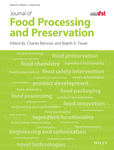Statistical optimization of ethanol fermentation parameters for processing local grape cultivars to wines
Funding information: DST, New Delhi (INSPIRE Fellowship Program to Pooja)
Abstract
Grape juice from two local grape cultivars viz. Punjab MACS purple and H-144 was subjected to prefermentation skin treatment. Ethanol fermentation w.r.t agitation rate, temperature, inoculum size, and nutrient supplementation were optimized using Triple M medium following response surface methodology (RSM). RSM results were numerically optimized keeping temperature “in range” for red wine and “low” for white wine which showed agitation rate of 80 ± 1 rpm for 24 hr, diammonium hydrogen orthophosphate supplementation @ 150 mg/100 ml, inoculum size of 6.1 and 6.5% (vol/vol), and fermentation temperature of 24.6 and 21 °C as optimum for ethanol fermentation of red and white wines, respectively. Optimized results were validated on grape juice of Punjab MACS purple and H-144 cultivars that lead to 12.0 and 11.2 (%vol/vol) ethanol production, respectively. Gas chromatography mass spectrometry analysis revealed the presence of 41 volatile compounds in the form of phenols, alcohols, terpenes, esters, ketones, and amines that add to the nutraceutical and antioxidant value of the wines.
Practical applications
Present study provides the statistical optimized fermentation parameters for red and white wine production separately. Optimization of an efficient processing technology to produce local grape wines will help to reduce the price of wines so that they are available to common masses at affordable costs besides improving the economic status of grape growers in the state and providing valuable information to wine makers to establish winery under North Indian conditions. Use of synthetic grape juice (Triple M media; during off season of grapes) lead to optimization of ethanol fermentation parameters in two separate fashions considering fermentation temperature as key parameter. Gas chromatography mass spectrometry analysis showed the presence of flavonoids, terpenes, and esters increasing nutritive value of product, providing antioxidants to the consuming person.




